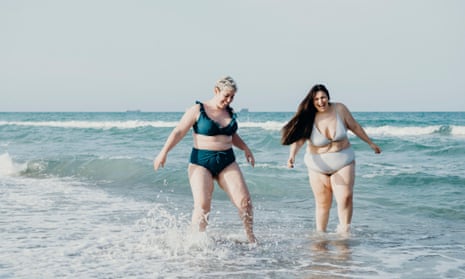To make sustainable swimwear, use eco-friendly materials like recycled nylon and opt for ethical manufacturing processes. Ensure durability and recyclability to extend the product’s life cycle.
Creating sustainable swimwear is crucial in the fight against environmental damage, a challenge that the fashion industry is actively addressing. The journey begins with the selection of materials, where options such as recycled plastics, transformed into high-quality fabrics like Econyl or Repreve, are favored.
These innovative fabrics not only help clear pollutants from our oceans but also provide the stretch and comfort needed for swimwear. Designers and brands now prioritize longevity and timelessness in their swimwear lines, moving away from fast fashion tendencies that contribute to waste. Such eco-conscious swimwear also appeals to a growing market of environmentally aware consumers, driving demand for products that align with their values. Ensuring that the production process is transparent and fair-trade certified helps maintain ethical standards and supports sustainable practices from start to finish.

Credit: www.brusselstimes.com
Green Waves: The Rise Of Sustainable Swimwear
The ocean calls for care as much as it calls for adventure. Conscious consumers dive into sustainable swimwear. Creators craft fashion that honors the sea. Together, they ride the green waves of change. This article explores how sustainable swimwear is taking over beaches worldwide.
Market Demand For Eco-friendly Options
Demand grows for green fashion. Swimmers seek swimsuits that don’t harm the planet.
- Customers prefer eco-friendly materials.
- Brands offer recycled fabrics and natural fibers.
- Sustainable swimwear sees rising sales.
Swimwear goes green as buyers choose the planet.
Environmental Impact Of Traditional Swimwear Production
Traditional swimwear often hurts nature. It’s time for a change.
| Traditional Swimwear | Sustainable Swimwear |
|---|---|
| Uses synthetic fibers | Employs recycled materials |
| Reduces pollution | |
| Contributes to ocean debris | Supports cleaner oceans |
Eco swimwear offers a brighter future for fashion and fish.

Credit: www.oprahdaily.com
Materials Matter: Choosing Eco-friendly Fabrics
Crafting sustainable swimwear starts with the right fabric choices. Environmentally kind options not only help our planet but also offer durability and comfort. Dive into eco-friendly materials that transform fashion into a force for good.
Recycled Plastics And Their Role In Swimwear
Recycled plastics have revolutionized swimwear production. By turning what would be waste into wearable materials, this process reduces environmental impact. Here’s how recycled plastics make a difference:
- Less Waste: They use existing materials.
- Energy Efficient: It requires less energy to produce than new fabrics.
Quality swimwear often features recycled polyethylene terephthalate (rPET), sourced from plastic bottles. This material boasts similar qualities to virgin polyester, offering both resilience and flexibility essential for swimwear.
Natural Fibers: A Viable Alternative?
Considering natural fibers brings us to materials like organic cotton and bamboo. But are they suitable for swimwear? Let’s compare:
| Material | Pros | Cons |
|---|---|---|
| Organic Cotton | Soft, hypoallergenic | Slower to dry, less elastic |
| Bamboo | Eco-friendly, antimicrobial | Can be less durable when wet |
While natural fibers are kind to the earth, their performance in water may fall short for swimwear needs. Their use is more complex in this industry.
Innovations In Biodegradable And Regenerated Textiles
Innovation in textile technology has introduced new heroes to the sustainable swimwear scene. These materials break down after use or re-enter the production cycle, leaving minimal trace behind. Examples include:
- Biodegradable fabrics like Amni Soul Eco®,
- Regenerated nylon, like Econyl®.
Biodegradable fabrics decompose in landfills, significantly quicker than traditional materials. Regenerated textiles offer a closed-loop solution, turning waste into resource repeatedly. Both options signal a responsible step for swimwear sustainability.
Ethical Production: Beyond The Fabric
Crafting sustainable swimwear is not just about choosing eco-friendly materials. It’s about ensuring every step of production upholds ethical standards. Care for workers and the planet stands at the forefront of such practices. In this space, we delve deeper into how ethical production transcends fabric choices and dives into fair labor, reduced carbon footprints, and effective waste management.
Fair Labor Practices In Swimwear Manufacturing
Ethical swimwear brands prioritize the wellbeing of their workers. They ensure fair wages, safe working conditions, and reasonable working hours. These brands often flaunt certifications like Fair Trade or SA8000. They reflect commitment to humane factory environments and respect for labor rights. Transparency in the supply chain is key, and many brands now share insights into their manufacturing processes.
Reducing The Carbon Footprint Of Production
- Energy-efficient manufacturing: Utilizing renewable energy minimizes carbon emissions.
- Local production: Keeping manufacturing close to the market reduces transport-related emissions.
- Eco-packaging: Recycled or biodegradable packaging options are essential.
Brands committed to reducing their carbon footprint often participate in carbon offset programs. They invest in projects that restore forests or develop clean energy.
Water Use And Waste Management
Water is vital in dyeing and treating fabrics. Ethical production means using methods that reduce water consumption and prevent pollution. Many sustainable swimwear manufacturers employ water recycling systems to achieve this. They strive to minimize waste during production. Surplus materials become new products instead of heading to landfills.
| Practice | Benefit |
|---|---|
| Digital printing | Less water and dye used |
| Material recycling | Reduces waste and resource use |

Credit: www.theguardian.com
Design With Longevity In Mind
Creating sustainable swimwear isn’t just about the materials used. It also involves designing pieces that last. Swimsuits that withstand time and trends contribute to sustainability by reducing waste and consumption. Let’s dive into how designing with longevity can create enduring swimwear.
Creating Timeless Swimwear Styles
- Select neutral colors that remain fashionable year after year.
- Include classic cuts that flatter a range of body types.
- Avoid overly trendy patterns and embellishments that go out of style quickly.
Durability And Quality Over Quantity
| Design Feature | Benefit |
|---|---|
| High-quality fabrics | Resist wear and tear from chlorine and saltwater. |
| Reinforced stitching | Prevents seams from fraying or coming undone. |
| UV resistance | Protects fabric color and structure from sun damage. |
Maintenance Tips To Prolong Product Life
- Rinse immediately after use to remove salt, chlorine, and sunscreen.
- Gentle washing in cold water preserves fabric integrity.
- Avoid high heat from dryers; air dry instead to maintain shape and elasticity.
Promoting A Sustainable Swimwear Brand
Embracing sustainability reshapes the swimwear industry. Brands now focus on eco-friendly materials and ethical practices. Success involves more than just product creation. It’s about effectively communicating the brand’s values and mission. This involves engaging with eco-conscious consumers, cultivating a community, and establishing trust through transparency and partnerships.
Marketing Strategies For Eco-conscious Consumers
To attract eco-aware buyers, brands use various marketing approaches. These strategies highlight sustainable practices through:
- Clear messaging on tags and branding materials that detail environmental benefits.
- Creating engaging online content that focuses on eco-friendly swimwear benefits.
- Sharing behind-the-scenes insights into the creation process and fair labor conditions.
- Social media campaigns that engage consumers and encourage responsible swimwear choices.
- Establishing a brand presence at sustainable fashion events and pop-up stores.
Building A Community Around Sustainability
Growing a community establishes a brand beyond just transactions. Methods include:
- Launching ‘wear and care’ initiatives that educate on extending swimwear lifespan.
- Hosting sustainability workshops and beach clean-up drives.
- Encouraging customer testimonials on green practices and product durability.
- Starting conversations through blog posts and forums on conserving marine life.
- Developing a loyalty program that rewards sustainable purchasing behaviors.
Collaborations And Certifications To Look For
Partnerships and certifications bolster credibility in the eco-friendly space:
- Seeking collaborations with environmental organizations amplifies outreach and impact.
- Obtaining certifications from bodies like Oeko-Tex assures customers of material safety.
- Teaming up with influencers who advocate for green living extends brand reach.
- Aligning with other sustainable brands creates powerful co-branded products or campaigns.
- Featuring third-party endorsements boosts consumer trust and validates claims.
The Future Of Swimwear: Trends And Innovations
As we dive into the future of swimwear, a wave of trends and innovations promises a stylish and environmentally conscious experience. Designers and brands embrace new technologies and eco-friendly materials. They aim for a cleaner ocean with every swimsuit. Sustainable swimwear is not just a trend; it’s becoming the industry standard. Let’s explore how innovations shape our swim attire.
Technology’s Role In Sustainable Swimwear
Recent advances in technology are making sustainable swimwear more accessible and appealing. Recycled materials such as fishing nets turned into nylon fabric are hitting the market. High-tech 3D printing reduces waste by creating precise designs. Digital fabric printing uses less water than traditional methods. These innovations signal a sea change in how we approach swimwear production.
The Shift Towards A Circular Fashion Economy
The circular fashion economy revolves around reducing waste and extending the life cycle of products. Swimwear brands are adopting a circular approach. They design products that can be recycled or upcycled. Take-back programs and recycling initiatives are creating sustainable loops within the industry. Customers are encouraged to return their worn swimwear for brand credits.
- Design with sustainability in mind
- Use eco-friendly materials
- Create recyclable and upcyclable products
- Implement take-back programs
Consumer Behavior And Its Drive Toward Change
Consumer demand is a powerful force in driving the sustainability movement. Shoppers actively seek out eco-friendly swimwear brands. They favor products with transparent supply chains and ethical production methods. Social media campaigns and influencers are highlighting the importance of responsible fashion. This consumer awareness is leading to more sustainable purchasing decisions.
- Seek eco-friendly brands
- Support transparent supply chains
- Prioritize ethical production
- Use social media for awareness
Frequently Asked Questions On How To Make Sustainable Swimwear
What Is Sustainable Swimwear?
Sustainable swimwear is made from eco-friendly materials. It reduces environmental impact. Production focuses on ethical practices and durability. It’s often from recycled plastics, like fishing nets.
How To Choose Eco-friendly Swimwear?
Look for swimwear with sustainable fabrics, like recycled polyester. Check for certifications, such as GOTS or OEKO-TEX. Choose brands that emphasize ethical manufacturing and longevity in their products.
Benefits Of Wearing Sustainable Swimwear?
Wearing sustainable swimwear helps reduce waste and ocean pollution. It supports ethical labor practices. Customers feel positive about their environmentally conscious choice. It also often offers high durability.
What Fabrics Are Used In Sustainable Swimwear?
Sustainable swimwear utilizes fabrics like recycled nylon, polyester, and Econyl. These materials are often repurposed from ocean waste. Plant-based options like organic cotton or hemp are also used.
Conclusion
Embracing sustainable swimwear is key for protecting our oceans. By choosing eco-friendly materials and ethical manufacturing, each swimsuit can make a wave of difference. Let’s dive into sustainability together; it’s time to swim with purpose. Remember, the tide is turning—join the current of change.

